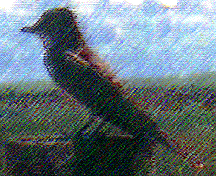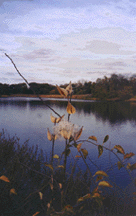|
|
| |||||||||||||||
|
| ||||||||||||||||
|
November 8, 1998 |
|
diving ducks | ||||||||||||||
|
|
|
| ||||||||||||||
Copyright © 1998, Janet I. Egan |
|
I used to have a hard time finding things to like about November until I discovered that Rhode Island is like Club Med for ducks and November is when they arrive in large numbers. Blessed with a mild day by November weather standards, we took advantage of the fact that one of the best places to get a close look at some of these winter visitors is Watchemocket Cove, an urban place that is also quite wild.
Nancy went for a walk while I counted ducks and watched the hooded mergansers and the buffleheads dive. A flock of buffleheads and a flock of hoodies were in close proximity and easily viewable from the bridge, so I got a chance to compare their diving behavior. The buffleheads all seem to dive at once - kind of a group thing. The hoodies dive one at a time. The buffleheads dive deeper and stay down longer. That got me wondering if they eat different things. On the other side of the road, over by the golf course, were way more wigeons than any other kind of duck. The way the sun was playing off the white "bald" pates I couldn't make out which one of the 102 is the Eurasian wigeon. I guess I was lucky with the lighting and the lone Eurasian one's location last time. The numbers of wigeons are always much greater than buffleheads, mergansers, or goldeneyes, etc. That got me wondering if the difference in flock size might be related to differences in what they eat - like can the cove support the eating habits of more wigeons because it has more wigeon grass (one of their favorite foods)? Nancy came back to where I was standing photographing some milkweed pods that had just opened, and told me that the reeds look magnificent with all their seed heads waving in the wind and glowing in the late afternoon light. I walked down the road with her to look at them. They looked almost magical. Grasses are gorgeous in November, the soft down that carries the seeds off on the wind looks so delicate and silvery. I can see why people imported Phragmites for ornamental plantings. They are just stunning in November. It's too bad they are invasive and taking over the marshes where they drive out the Spartina and don't provide adequate habitat for the marsh creatures. Back home with all these questions on my mind, I dragged out Bellrose's Ducks, Geese, and Swans of North America, which is the standard reference that all my other books refer to (that's why I finally bought it). According to Bellrose, the food habits of the hooded merganser aren't very well known. From a couple of studies of stomach contents in small numbers of hoodies in the late 1930's and early '40's, they eat a lot of fish: yellow perch, sunfish, bass, and some crustaceans. One of the studies also timed their dives compared to goldeneyes:
And since my grass identification skills aren't on a par with my bird identification skills, I have no idea about the relative abundance of wigeon grass. I'm gonna hafta look that one up in a plant book. | ||||||||||||||


